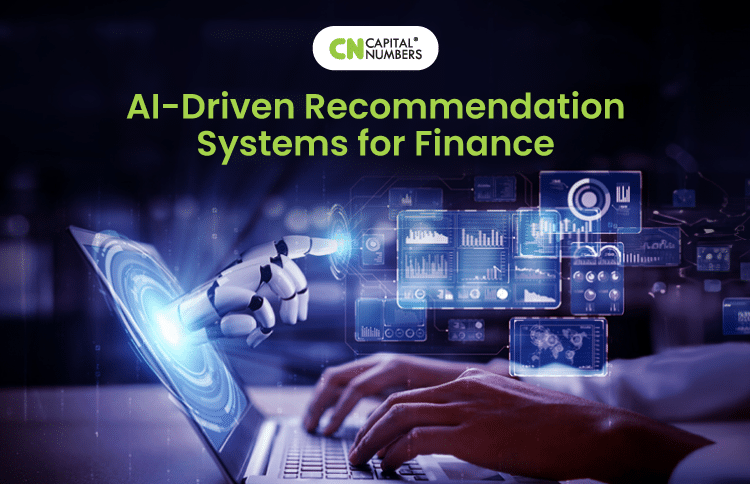AI-Driven Recommendation Systems for Finance
Table of Contents
Today’s technological advancements are increasingly driven by Artificial Intelligence (AI). AI’s impact is widely recognized, powering progress across various sectors. Within AI, Recommendation Systems or Recommender Systems (RS) are transforming how we interact with technology, offering personalized experiences and enhancing user engagement. These systems utilize AI to tailor content, services, and products to individual preferences. They are applied in numerous fields, including E-commerce, News, Healthcare, Streaming Services, Social Media, Travel, Online Learning, Stock Markets, and Financial Services.
Recommender Systems, fueled by machine learning and big data, anticipate user preferences based on past behavior, demographics, and other factors. Beyond mere suggestions, RS can customize experiences, such as creating personalized learning paths, devising unique workout plans, or even generating music tailored to individual tastes. Moreover, RS supports decision-making in financial planning, medical diagnosis, and legal research by providing data-driven insights for complex decisions.
Types of Recommendation Systems:
Collaborative Filtering:
Collaborative Filtering (CF) is a powerful technique used in Recommendation Systems to suggest items to users based on similar user preferences or similar items. It analyzes user behavior data like previously given ratings or purchases, etc., to identify similarities between users and similarities between items. It’s like having a friend recommend a movie they loved because they both enjoy the same genre or an online store suggesting related products based on what others who bought the item the user is viewing also purchased. Its effectiveness depends on the specific application and data available.
This system recommends items based on two types:
- User-based filtering: The system analyzes user similarities based on their historical interactions with items. Users who have similar preferences are considered ‘neighbors’. The data used for this type includes information like purchase history, ratings, searches, and even demographics. The system identifies their nearest neighbors based on past interactions with a specific user. The system then recommends items these neighbors liked but the target user hasn’t interacted with yet.
- Item-based filtering: The system analyzes item similarities based on shared features or user interactions. Items with similar characteristics are considered ‘neighbors’. The data used are product descriptions, features, categories, and other attributes describing the items. The system identifies its nearest neighbors for a specific item based on common features or shared users. The system then recommends similar items to users who interact with these neighbors.
Challenges of Collaborative Filtering:
- This method requires sufficient user interactions for accurate recommendations.
- New items or users with limited data can be challenging to recommend.
- It is susceptibility to bias, which can reflect biases present in the data.
Applications of Collaborative Filtering:
- E-commerce recommendationsMovie and music streaming recommendations
- Movie and music streaming recommendations
- Social media friend/connections suggestions
- News article recommendations
Content-based Filtering:
Content-based filtering (CBF) is another powerful technique used in recommendation systems that focuses on the items’ characteristics like features, descriptions, etc. It offers a complementary approach to collaborative filtering. It is useful when user data is limited, or items are new and have no ratings. It is like a personal shopping assistant who analyzes the characteristics of different items and suggests ones that match the user’s expressed interests and previous purchases. The data used by CBF includes past interactions with items, such as ratings, purchases, searches, browsing behavior, descriptions, features, categories, and other attributes that capture the essence of each item.
The system creates a profile of the user’s preferences by analyzing the user’s past interactions with items. This profile can include keywords, features, categories, or other representations of your interests. The system analyzes the features of each item in the system.
While making recommendations, the system compares the item features to the user’s profile, identifying items with features that closely match their preferences. Then, the system recommends these items to the user, believing they will likely be interesting based on their past behavior. Users can understand why an item is recommended based on its features. This method can work with limited user data as long as item features are rich and can suggest new or niche items with detailed feature information.
Challenges of Content-based Filtering:
- Recommendation can be difficult for new users with limited data or for items with limited features.
- It requires careful selection and representation of item features to be effective.
- This method may not capture complex user preferences or hidden connections.
Applications of Content-based Filtering:
- Articles or videos recommendation based on keywords and topics.
- Music recommendation based on genre, artist, and audio features.
- Recommending similar products based on technical specifications and functionalities.
- Personalizing news feeds based on user-defined interests and categories.
Knowledge-based Filtering:
Knowledge-based filtering (KBF) is a different type of recommendation system from collaborative filtering and content-based filtering. Instead of relying on user behavior or item features, it uses explicit knowledge about items and users, like product categories, user preferences, etc. It also uses the relationships between them to generate recommendations. Imagine it like a wise consultant who uses their domain expertise and predefined rules to guide you towards suitable options.
The system gathers domain knowledge through various means, such as human expertise about the domain structured representations of domain knowledge, including concepts, relationships, hierarchies, product specifications, and user profiles.
The system applies the acquired knowledge to reason about recommendations, including rule-based and case-based reasoning. In rule-based reasoning, predefined rules are applied to match user profiles with suitable items based on their characteristics and constraints. In case-based reasoning, past cases are used where similar user profiles were compared with successful recommendations. Based on the reasoning process, the system identifies items that best match the user’s profile and preferences according to the defined knowledge. Then, these items are presented to the user as recommendations.
Benefits of Knowledge-based Filtering:
- This method is more flexible as knowledge can be easily adapted and updated to reflect changing needs or domain shifts.
- With this method users can understand the reasoning behind recommendations based on the applied rules.
- Recommendations can be made even for new users or items with limited data, leveraging the explicit knowledge.
Challenges of Knowledge-based Filtering:
- Building and maintaining comprehensive domain knowledge can be time consuming and expensive.
- Scalability is again a challenge where maintaining performance with large datasets or complex knowledge rules can be challenging.
- May not capture implicit user preferences or complex relationships not explicitly defined.
Applications of Knowledge-based Filtering:
- Financial products or services recommendation based on user profiles and risk tolerance.
- Configuring IT systems based on user needs and device compatibility.
- Recommendation of learning materials based on student profiles and learning goals.
- Recommending medical treatments based on patient diagnoses and clinical guidelines.
Hybrid Recommendation Systems
These systems combine collaborative filtering and content-based filtering approaches, which leverage the power of both methods for more robust and accurate recommendations. The essence of hybrid systems is that they combine various filtering techniques to overcome individual limitations and deliver superior recommendations. Consider the example where the recommendation system utilizes user behavior patterns from CF to capture your evolving preferences, then leverages item features from CBF to recommend similar products even if they’re new, and lastly incorporates expert knowledge from KBF to suggest niche items tailored to your specific needs.
Common Hybrid Approaches:
- Weighted Hybrids: This approach assign weights to different techniques based on their effectiveness or data availability in a specific scenario.
- Mixed Hybrids: It applies different techniques to recommend diverse item sets and then combine them for final recommendations.
- Cascading Hybrids: This approach uses one technique to generate candidate items and then refine them using another technique.
Benefits of Hybrid Systems:
- This method shows improved accuracy as it uses diverse data sources and captures both user behavior and item characteristics for better relevance.
- It also addresses the limitations of individual methods in recommending for new users or items.
- This method caters to individual preferences while also suggesting diverse and potentially interesting items.
- Depending on the hybrid approach, recommendations can be explained based on the contributing factors from different techniques.
Challenges of Hybrid Systems:
- Designing and implementing effective hybrid systems requires expertise and careful consideration of different techniques and their interactions so it comes with the cost of increased complexity.
- Data integration is another challenge as combining data from different sources may require preprocessing and harmonization for compatibility.
- Running multiple recommendation techniques can be computationally expensive, especially for large-scale systems.
Applications of Hybrid Systems:
- E-commerce product recommendations, combining user purchase history, product features, and expert ratings.
- Movie and music streaming recommendations, integrating user watch/listen history, genre information, and editorial picks.
- News article recommendations, considering user reading behavior, article topics, and expert opinions.
Recommendation Systems for Financial Services:
In financial decision-making, where every thread holds the potential for significant gain or loss, the accuracy of associated recommendations is important. While knowledge-based filtering (KBF) offers a promising thread in this domain, it needs expert knowledge, dynamic adaptability, and an appreciation for the data’s multifaceted symphony.
KBF’s strengths lie in its transparency, ability to empower investors with understandable rules, and ability to scrutinize recommendations. It can also offer valuable insights for new companies and investors with limited data. However, its strength lies in the resource-intensive nature of knowledge acquisition and the challenge of scaling across diverse asset classes and ever-evolving markets. Additionally, it can struggle to capture the unspoken language of the market, the subtle nuances that defy explicit definitions. Financial data demands an ability to integrate and reason about diverse sources, from financial statements to the whispers of market sentiment. KBF must continuously refine its knowledge and rules to stay ahead of the curve.
Incorporating advanced financial software development techniques can significantly enhance KBF’s capabilities. These techniques allow for better integration and reasoning about diverse sources of information, from financial statements to market sentiment whispers. Financial software development is key to refining KBF’s knowledge and rules continuously to stay ahead of market changes.
But most importantly, it must incorporate robust risk management strategies with a safety margin. Machine learning’s ability to unveil hidden patterns and trends can augment KBF’s insights. Hybrid approaches combining KBF with other techniques, like collaborative or content-based filtering, can leverage user behavior and item features for a more personalized and data-driven experience. As financial services recommendations need to be handled carefully, below are some methods that help make recommendations easier.
Types of Recommendations in Financial Services:
Venture-Investor Matching: This approach will match investors with suitable ventures based on factors like investor profile, venture characteristics, and historical data. All these factors are mentioned below.
- Investor profile: One of the important factors for matching is risk tolerance, investment goals, and investor industry expertise.
- Venture characteristics: This includes the stage of development, sector, growth potential, and funding requirements.
- Historical data: This refers to past investment performance, portfolio composition, etc.
- Portfolio Optimization: The core of this method is recommending diversification strategies and suggesting new ventures to balance and optimize an existing portfolio.
- Market Insights: Identifying promising sectors, emerging trends, and undervalued ventures based on market analysis and data scraping.
Challenges Associated with Financial Recommendations:
Making financial recommendations is many times a challenging task as its success depends on many certain and uncertain factors. Some of the major challenges are listed below.
- Data Availability: This is a very important challenge as, many times, accessing reliable and comprehensive data on ventures and investors can be difficult.
- Risk Assessment: Accurately evaluating investment risks through AI algorithms requires careful design and validation.
- Regulatory Compliance: Ensuring recommendations comply with financial regulations and ethical standards is important.
- Transparency and Explainability: Investors need to understand how recommendations are generated and trust the algorithms behind them.
Potential Benefits of Financial Recommendations:
- Increased Efficiency: As matchmaking investors and ventures are performed more effectively, it saves time and resources.
- Diversification and Risk Management: We can optimize portfolios for better risk-return balance.
- Discovery of Hidden Gems: Ability to identify promising ventures that traditional methods might overlook.
- Democratization of Investment: Making valuable insights accessible to a wider range of investors.
Other Applications of Recommender Systems
As mentioned above, there are many day-to-day applications where people can use recommendation systems. Below are a few common applications of it.
- E-commerce: On online shopping websites, RS suggests relevant products based on users’ browsing history and purchase patterns.
- Healthcare: In healthcare applications, it is useful for recommending treatment options based on medical data and personalized risk factors.
- Streaming Platforms: In this domain, service providers give individual users tailored movie and TV show suggestions.
- YouTube: Company provides curated video recommendations based on user’s watch history and viewing behavior.
- Stock Markets: Many companies use RS in this domain to provide personalized investment recommendations based on risk tolerance and financial goals.
- Education: Used for course recommendation based on personalized individual learning styles and needs.
- Social media: In this sector, RS is commonly used to suggest relevant connections and groups based on interests and online behavior.
- City Planning: Used to optimize traffic flow and resource allocation based on real-time data and user preferences.
Challenges of Recommendation Systems
A few important challenges are highlighted below.
- Bias and Fairness: As the strength of RS lies in the data quality, sometimes algorithms can perpetuate biases present in the data on which they’re trained, leading to discriminatory recommendations.
- Privacy Concerns: Balancing personalization with user privacy is crucial to ensure trust and ethical implementation.
- Explainability and Transparency: Understanding how these systems make recommendations builds trust and avoids “black box” decision-making.
The Future of Recommendation Systems
As AI continues to evolve, recommender systems will become even more sophisticated and ubiquitous, like,
- Contextual Awareness: Recommendations will adapt to real-time context, like your mood, location, or current activity.
- Multimodal Interactions: Imagine AI systems recommending products based on your purchase history, social media interactions, and emotional state.
- Lifelong Learning: Recommender systems will continuously learn and adapt to your evolving preferences and needs.
Recommendation Systems are a powerful force shaping our interactions with technology. By understanding their potential and limitations, we can leverage them to enhance our lives while ensuring responsible and ethical development.
Planning to integrate an AI-driven Recommendation System into your next business application? Contact us! At Capital Numbers, we craft custom software solutions on demand, tailored to your unique needs.

















